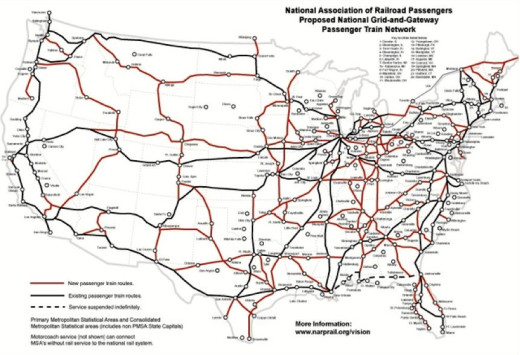Continued from Rail Redux – Part 1: the value rail stations hold to communities, and a look at some exciting rail-related development projects in the works.
What Factors Will Drive a True Rail Resurgence?
1. Robust Train Network
The National Association of Railroad Passengers (NARP) believes the current Amtrak system is skeletal at best.
What will be needed over the coming decades is an interconnected network of new and more frequent routes and long distance trains with modern equipment, dependable service, attractive stations, and affordable fares to provide mobility options for citizens. NARP reports that: “Experience has shown that when additional frequencies are added to existing routes, revenues rise faster than costs. When new routes are added, ridership on connecting routes also goes up.” 1
NARP’s Grid and Gateway proposal is one model for an expanded national system. 2
All routes shown would have at least two round trips daily to maximize utility and connection possibilities.
2. Air-Rail Connectivity
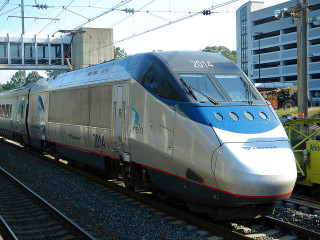
Few airports in the United States coordinate with trains to carry passengers to their destinations. Amtrak accounted for just 3% of all airport access at Newark, 2% at Baltimore, and less than 1% at Burbank. Newark is the only airport with an agreement between Amtrak and an air carrier (United) to let passengers reserve seats on both modes at the same time. 3
But the Miami Intermodal Center (MIC), a $2 billion ground transportation hub may be the game changer in air-rail connectivity.
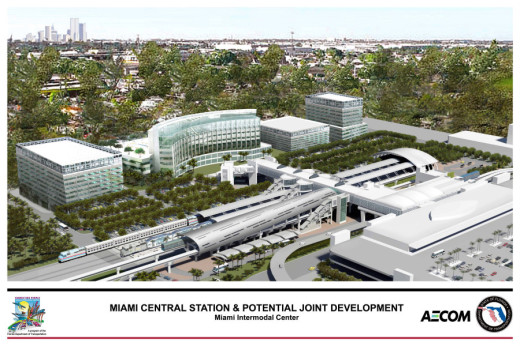
When complete, MIC — located just east of Miami International Airport — will provide connectivity for air, rail (with a new station for Amtrak and the Tri-Rail commuter service), and bus transit between Palm Beach County, Fort Lauderdale, Miami, and the Florida Keys, making regional travel easier for residents and visitors. 4
3. Public High Speed Rail
The US High Speed Rail Association, an independent, nonprofit, trade association envisions a 17,000 mile national high speed rail system by 2030, connecting regions, cities, and towns in an integrated, multi-modal system. Among the principal benefits: revitalizing the economy, reducing congestion, and cutting the nation’s carbon footprint. 5

More strategically, Amtrak will concentrate its high speed rail efforts along the Northeast Corridor (NEC) between Washington, D.C. and Boston to meet the mobility needs of this economically powerful megaregion. Phase 1, known as the NEC Upgrade Plan (“NEC-UP”), will bring the Northeast Corridor to a state of good repair between 2012 and 2025 and lay the groundwork for dedicated high-speed rail service. Phase 2, the Next-Generation High-Speed Rail Program (“NextGen HSR”), will be dedicated to the development and advancement of high speed rail services along the Northeast Corridor between 2025 and 2040. 6
Amtrak projects that high speed rail’s huge reductions in travel time, increases in train frequencies, and overall service quality would result in a 44% increase in NEC ridership. Close to three-fourths of the new riders would be those who would otherwise travel by highway (47%) or air (23%), with the balance representing “induced” trips -– that is, travelers making trips they would otherwise not have made by any mode. 7
These rail infrastructure investments in tandem with real estate projects and transit oriented developments could drive a real rail resurgence and downtown revitalization.
4. Private High Speed Passenger Rail
All Aboard Florida’s planned 32 daily train trips between Miami, Fort Lauderdale, and West Palm Beach represents a significant potentially groundbreaking investment in frequent, high speed rail.
All Aboard Florida’s planned 32 daily train trips between Miami, Fort Lauderdale, and West Palm Beach represents a significant, potentially groundbreaking, investment in high speed rail. But will private rail’s first foray in America in 30 years succeed?
According to Adie Tomer of the Brookings Institution’s Metropolitan Policy Program (as quoted in a recent article about All Aboard Florida’s plans) “If it can work [in Florida], it could work in other markets. … This a great test for America.” 8
Editor’s Note: perhaps holding even greater potential is the private Texas Central High-Speed Rail project, planned to connect Dallas and Houston — 230 miles apart — with Japanese Shinkansen-style bullet trains, providing 205 mph rail service and 34 daily trains each way … operating by 2021! 9 For those interested, a detailed presentation about the Texas project can be viewed on YouTube.
Photo of Japanese Shinkansen train by Marufish; Flickr Creative Commons license.
Rail Resurgence and Revitalization in North Carolina’s Triangle Region
What’s the best way to travel the 262 miles from Washington, DC to Raleigh, North Carolina?
What’s the best way to travel the 262 miles from Washington, DC to Raleigh, North Carolina?
Three Washington Post writers each took a different mode of travel — train, plane and car — from Washington to downtown Raleigh. The results: The plane was the fastest and the car cheapest, but neither was a pleasant experience. The winner? Amtrak’s Carolinian for its comfort, scenic views, low cost, and pretty good Wi-Fi. The downside? A 5 hour and 47 minute run. 10
The verdict on the Carolinian syncs with North Carolina’s plans to make train travel more reliable, convenient, and faster. In the works, a 90 minute reduction in travel time between Raleigh and Washington, and trains as fast as 110 mph between Raleigh and Richmond.
Currently, eight trains daily (including the Carolinian) provide service to some 200,000 people annually from Amtrak stations in Raleigh, Durham, and Cary to stops in Greensboro, Charlotte, and 11 other North Carolina cities, as well as Florida and the Northeast. Durham and Cary have recently renovated and expanded their train stations. The Triangle stations are also slated to be part of a potential Southeast Corridor High Speed Rail.
Raleigh is investing in a $73 million, 34,000 square feet intermodal station at the old Dillon supply viaduct building in the downtown warehouse district. The station will function as the hub for Amtrak and the proposed high-speed rail route between Washington, D.C. and Atlanta. It will also serve as a transfer point for commuter rail, light rail, and bus transit — and house retail storefronts and restaurants.
The station is already the impetus for a new mixed-use district with 2.5 million square feet of retail and office space and 6,000 residential units, within a half mile radius of the intermodal center. This landmark project is expected to open in 2017. 11
For a good overview of Raleigh’s Union Station project, take a look at the three minute video above.
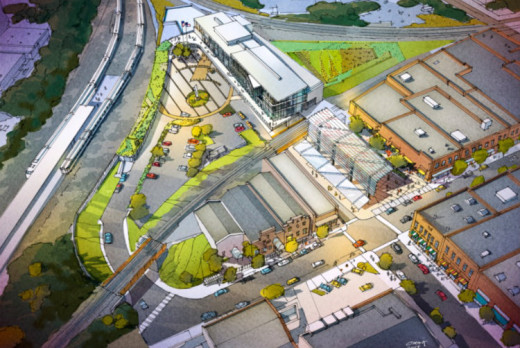
The architects’ detailed drawings of the building and platforms show a major transformation from the current brick warehouse design. The renovations will create glass-paneled walls and sunlight through much of the building, while keeping remnants of old steel panels. “We also want to celebrate the rich industrial heritage,” said architect Steve Schuster. 12
Downtown Durham is a mix of the bohemian, foodie, and art & culture scene, a smattering of new and restored residential and commercial real estate all anchored by the Durham Performing Arts and the American Tobacco Warehouse district. The Durham Amtrak station in the restored Walker Warehouse is part of downtown Durham’s homage to its tobacco, textile, and railroad history — and ongoing revitalization.
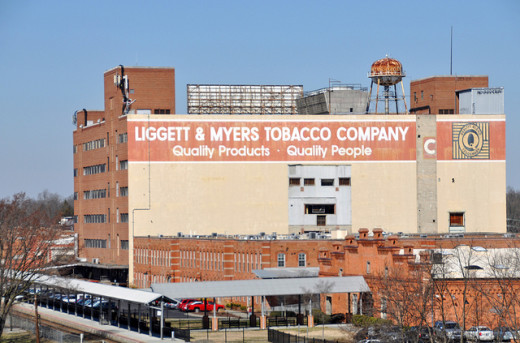
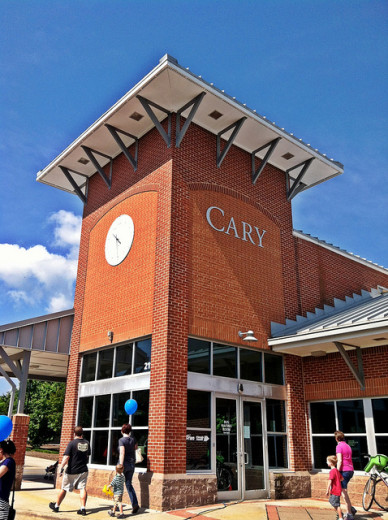
The Town of Cary’s 6,200-square-foot Amtrak station in the heart of downtown lies within walking distance of the town’s arts center, downtown theater, and planned boutique hotel and urban park.
The station’s role as a catalyst for real estate growth has potential with the development of a four story, multi-family, mixed used development across the street. The project could spark a commercial revitalization of Chatham Street based on residents’ everyday needs -– grocery store, coffee shops, restaurants.
Thanks to federal and state investment in rail infrastructure and local government and private investment in Main Street arts & culture, small business, and real estate, there is every indication that Triangle train stations are well positioned to serve as transit hubs and contribute to the renaissance of their downtowns.
Deepa Sanyal is a Community Planning consultant and Training Professional. She provides professional services to local governments, communities, universities, and civic organizations seeking guidance on comprehensive planning, community assessments & revitalization, historic preservation, and cultural tourism. Deepa also advocates for and writes about sustainable development issues, and serves on the Chatham County Planning Board in her “Corner of the Triangle.”
Notes:
- NARP’s Vision for Trains in America. See also Malcolm Kenton, “Frequency is Key to Successful Short-Distance Passenger Train Service” (NARP, 2011). ↩
- National Association of Railroad Passengers, Grid & Gateway Proposal. ↩
- Eric Jaffe, “Why Don’t More U.S. Airports Connect to Amtrak?” (CityLab, August 7, 2013). ↩
- Miami Intermodal Center web site. ↩
- Editor’s note: the question of which mode of transportation is best environmentally is surprisingly complex. One good starting point is an article by Jacob Leibenluft, “Trains vs. Planes vs. Automobiles: Is It Always Greener to Take Public Transportation?” published on Slate.com (Nov. 25, 2008). To further sample the growing literature, see Irene Kwan, “Planes, Trains, and Automobiles: Counting Carbon” (The International Council on Clean Transportation, Sept. 19, 2013). For a perspective from rail advocates, see, for example, the estimated greenhouse gas emission reductions the California High-Speed Rail Authority projects from the state’s planned high-speed rail system. Finally, take a look at my own post about the Portland, Oregon, Metro Area’s efforts to reduce carbon emissions. ↩
- See Amtrak Northeast Corridor – Planning for High-Speed Rail (June 17, 2014). ↩
- “A Vision for High-Speed Rail in the Northeast Corridor” (Amtrak, September 2010), p.18. ↩
- Henry Grabar, “The Triumphant Return of Private U.S. Passenger Rail” (CityLab, Jun 17, 2014). ↩
- See Stephen J. Smith, Aman Batheja, “The Bullet Train That Could Change Everything In Texas, A New Model for High-Speed Rail Is Hurtling Forward” (Texas Tribune, Aug. 18, 2014). ↩
- Zofia Smardz, “Driving to Raleigh, N.C.: For control freaks, it’s the best way to go” (The Washington Post, May 15, 2014). ↩
- For more on the project, see Colin Campbell, “Raleigh Union Station plans add more retail for ‘vibrant, active space’” (News Observer, Feb. 27, 2014), and Union Station: Raleigh’s Multi-Modal Transit Center (City of Raleigh). ↩
- Ibid. Colin Campbell, “Raleigh Union Station plans add more retail for ‘vibrant, active space’.” ↩
